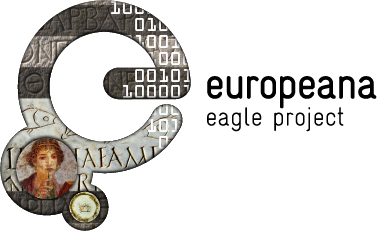EAGLE 2016 – Call for Participation
Important Dates
Deadlines: Midnight CEST (Central European Standard Time):
– Deadline for submission: September 8, 2015 September 27, 2015
– Notification of acceptance: September 30, 2015 October 30, 2015
– Final version of paper, posters and panels: October 30, 2015 November 20, 2015
– Conference: January 27-28-29, 2016
Call for Participation
Submissions are invited for papers, panel and posters (with or without demonstrations) featuring high quality and previously unpublished research on the topics described below. Contributions should focus on results from completed as well as ongoing research, with an emphasis on novel approaches, methods, ideas, and perspectives, whether descriptive, theoretical, formal or computational.
Proceedings will be published in time for the conference.
The proceedings of the previous edition are available here.
Motivation and Aims
Digital research has moved well beyond the stage of pilot projects; it is a mature discipline bringing contributions to its own field and others, most notably Classical Epigraphy, Ancient History and Archeology. Researchers and end-users of epigraphic editions and data now consult the internet before moving to printed material. It is therefore very important that the qualified information they find online be visible, reliable and curated. Infacts the development of the discipline has been such that technologies have been tailored to fit the exact purpose of researchers. The landscape of digital epigraphy is rich: Greek and Latin texts exist in the hundreds of thousands, bibliography, full text and meta-data are abundant (particularly on the Latin side). But the collective harvest of translations and images available in the digital space is quite thin.
To an extent, digital epigraphy today is the direct descendant of the discipline as practiced in the 19th century, but it now has the means (and the will) to go well beyond that model; it is now able to give to each text multiple contexts and multiple audiences. It allows all objects to be observed from a given, annotated findspot, often making readily available all relevant photos. The data can also be presented to the researcher and to the public, which is provided with links, expansions and possibilities to investigate further.
The question now becomes how to proceed with this momentum: how can we collectively move forward and obtain the best possible results for researchers and end users? Are the differences between digital and traditional epigraphers really as irreconcilable as they seem? Or can we all join forces for a better tomorrow? In this respect do traditional and digital epigraphers really have different approaches? Or are we all today digital epigraphist and should join in a change which is not just a trend?
General Track:
The topics to be addressed in the conference include (but are not limited to) the following:
-
Traditional and digital epigraphy
-
Digital approaches to cross-disciplinary studies of inscriptions
-
Virtual re-contextualization of inscriptions
-
Integration of epigraphy in wider contexts of digital infrastructures
-
Access to images of inscriptions
-
Best practices for Linked Open Data
-
Multimedia and Mobile applications
-
Cultural Heritage and the Social Web
-
Digital Epigraphy as a discipline
-
Metadata Models and Epigraphic Taxonomies
-
Epigraphic editions on paper and online
-
Harmonization and interoperability of digital editions of Inscriptions
-
The role of digital epigraphy in the Linked Ancient World Data networks
-
Future aims and perspectives on digital epigraphy
-
Connecting Museums and research projects on Epigraphy
-
3D, multimedia and GIS repositories, platforms, & projects related to inscriptions
- Successful projects
Thematic Workshops
GIS and Terminologies
Topics of a specific session organized by the Working Group 1 of the EAGLE BPN include (but are not limited to) the following:
-
Linking ancient data about places
-
Wikidata as the gazetteer of gazetteers
-
Bringing geographical information to the public
-
gathering and exploiting geographical data
-
maps and epigraphy
-
merging data and dealing with complex layered situation
-
fine grained GIS: case studies
-
GIS and 3D
-
definitions of vocabularies
-
dealing with peculiarities, recording multiple languages
-
alignment and harmonization
-
possibilities of exploitation of vocabularies
-
dating criteria for epigraphic material: possible approaches
-
matching museums, archeology and epigraphy: paths ahead towards further ways to build networks of data
Translations and Content Curation
Topics of a specific session organized by the Working Group 2 of the EAGLE BPN include (but are not limited to) the following:
-
existing projects on translations of inscriptions or including translations of inscriptions
-
methods and aims of translations of inscriptions
-
possibilities of enlargement of scope for translated materials
-
museums and translations of epigraphic documents
-
best practices for content enrichment by professionals and amateurs
-
the curation of content and the capacity of supporting its preservation
IPR and User Engagement
Topics of a specific session organized by the Working Group 3 of the EAGLE BPN include (but are not limited to)the following:
-
Services for specific user groups (e.g. educational projects)
-
Studies of user behavior and identification of user groups
-
Concepts to achieve the active participation of user groups
-
Best practices in data visualization and interpretation
-
Mining and interpretation of user engagement data
-
Guidelines for user engagement design
-
Presentations of successful applications
-
Museum specialists in classics
-
IT specialists for online user engagement
-
IT specialists for validation methods
-
Classics (Epigraphic) community involved in educational projects
-
Specialists in didactics of European Projects and comparable

